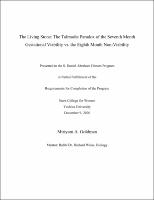Please use this identifier to cite or link to this item:
https://hdl.handle.net/20.500.12202/6577| Title: | The Living Stone: The Talmudic Paradox of the Seventh Month Gestational Viability vs. the Eighth Month Non-Viability |
| Authors: | Weiss, Richard Goldman, Miriyam A. |
| Keywords: | pregnancy premature birth viability of premature infants Halakhah Jewish law |
| Issue Date: | 9-Dec-2020 |
| Publisher: | New York, NY: Stern College for Women. Yeshiva University. |
| Citation: | Goldman, Miriyam A. The Living Stone: The Talmudic Paradox of the Seventh Month Gestational Viability vs. the Eighth Month Non-Viability. Presented to the S. Daniel Abraham Honors Program in Partial Fulfillment of the Requirements for Completion of the Program Stern College for Women Yeshiva University December 9, 2020. New York, NY. Mentor: Rabbi Dr. Richard Weiss, Biology |
| Abstract: | This paper reviews the viability of premature infants, specifically the halachic status of those born in the eighth month. There are several Talmudic verses stating that a seven-month old newborn is viable whereas an eighth month old newborn is not viable. This seems to contradict modern medical science. The fetus continuously develops from the first trimester though the third, with increasing maturation of the organ systems. It would seem logical that deliveries occurring later in gestation, such as in the eighth month, would have greater potential for viability than deliveries in the seventh month. However, there are certain rationalizations for this disparity including the possible miscalculation of the onset of pregnancy, statements about the possibility of two gestational periods, one at seven months and one at nine months, as well as certain features that indicate maturity, including hair and nails. Modern day halacha makes an effort to resolve this dilemma by accounting for the use of incubators and the neonatal intensive care unit (NICU) which maximize the survivorship of every birth regardless of the month in which the infant is born. This paper begins by introducing pregnancy and defining prematurity. The Talmudic and secular sources that expound on this are presented in detail. Statistics on survival rates of preemies are introduced to support why such an obvious quandary exists. The history of premature survival and key developmental differences of premature infants born at different months are then discussed followed by modern sources that attempt to integrate the Talmudic sources with current knowledge of fetal development. Concluding the paper are interviews with Rabbi Eitan Mayer, Rabbi Daniel Stein and Rabbi Dr. Richard Weiss regarding their understanding of this topic and how they interpret this dilemma today. |
| Description: | Senior honors thesis / Open-Access |
| URI: | https://hdl.handle.net/20.500.12202/6577 |
| Appears in Collections: | S. Daniel Abraham Honors Student Theses |
Files in This Item:
| File | Description | Size | Format | |
|---|---|---|---|---|
| Miriyam Goldman OA Thesis 9Dec20.pdf | 247.79 kB | Adobe PDF |  View/Open |
This item is licensed under a Creative Commons License

